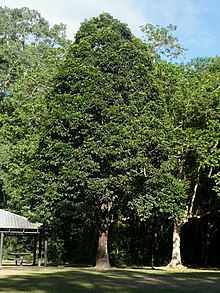| Bumpy satinash | |
|---|---|

| |
| In cultivation in Cairns November 2022 | |
| Scientific classification | |
| Kingdom: | Plantae |
| Clade: | Tracheophytes |
| Clade: | Angiosperms |
| Clade: | Eudicots |
| Clade: | Rosids |
| Order: | Myrtales |
| Family: | Myrtaceae |
| Genus: | Syzygium |
| Species: | S. cormiflorum |
| Binomial name | |
| Syzygium cormiflorum (F.Muell.) B.Hyland | |
| Synonyms | |
|
Eugenia hislopii F.M.Bailey | |
Syzygium cormiflorum, commonly known as the bumpy satinash, is a species of Syzygium tree endemic to Queensland in northeastern Australia.
Description
Syzygium cormiflorum can grow as a tall rainforest tree to 30 m (98 ft) in height with a trunk 1 m (3 ft 3 in) diameter at breast height (dbh). Trees with flowers on branches grow larger than those with flowers on the trunk. The trunk in the latter form has a pronounced bumpy texture. Large specimens can have buttressed trunks. The bark is fibrous and flakey. The leaves range from 6 to 21 cm (2.4 to 8.3 in) in length by 2.5 to 11.5 cm (0.98 to 4.53 in) wide. The flowers appear on the trunk (cauliflory) or larger branches (ramiflory) over most months of the year except December and January, but peak over July to September. These are followed by white or cream fruit which are 3 to 6 cm (1.2 to 2.4 in) in diameter.
Taxonomy
Victorian colonial botanist Ferdinand von Mueller described the bumpy satinash as Eugenia cormiflora in 1865, from a collection by John Dallachy at Dalrymple's Gap near Rockingham Bay in Queensland. It was transferred to the genus Syzygium in a revision of the genus in 1983. Eugenia hislopii, named by Frederick Manson Bailey in 1913, is a synonym. Common names include white apple, wild apple, watergum, Cairns satinash, and bumpy satinash.
Distribution and habitat
The range is from Townsville to the Iron Range from sea level to altitudes of 1,200 m (3,900 ft), with cauliflorous forms more common at higher elevations and ramiflorous at lower elevations. It is found in rainforest.
Ecology
The fruit is not particularly palatable to humans. The southern cassowary eats the fruit and flowers. The odoriferous black ant (Anonychomyrma gilberti) makes extensive tunnels in the cauliflorous form, particularly at the bumps where flowers grow.
Cultivation
Syzygium cormiflorum is rarely grown in gardens. Generally propagated from seed, it can take 8 to 12 years to flower. It can be grown in subtropical climates.
About 40 of these trees have been planted throughout the city of Cairns in Queensland.
Gallery
References
- ^ Hyland, Bernie P.M. (1983). "A Revision of Syzygium and Allied Genera (Myrtaceae) in Australia". Australian Journal of Botany Supplementary Series. 13 (9): 1–164. doi:10.1071/BT8309001. S2CID 89485920.
- "Eugenia cormiflora F.Muell". Australian Plant Name Index (APNI), IBIS database. Centre for Plant Biodiversity Research, Australian Government.
- "Syzygium cormiflorum (F.Muell.) B.Hyland". Australian Plant Name Index (APNI), IBIS database. Centre for Plant Biodiversity Research, Australian Government.
- "Eugenia hislopii F.M.Bailey". Australian Plant Name Index (APNI), IBIS database. Centre for Plant Biodiversity Research, Australian Government.
- ^ F.A.Zich; B.P.M.Hyland; T.Whiffen; R.A.Kerrigan (2020). "Syzygium cormiflorum". Australian Tropical Rainforest Plants (RFK8). Centre for Australian National Biodiversity Research (CANBR), Australian Government. Retrieved 27 May 2021.
- Walters, Brian (November 2007). "Syzygium cormiflorum". Australian Native Plants Society (Australia). Retrieved 14 April 2012.
- "TreePlotter". Cairns Regional Council’s Street and Park Tree Database. Retrieved 23 November 2022.
External links
 Data related to Syzygium cormiflorum at Wikispecies
Data related to Syzygium cormiflorum at Wikispecies Media related to Syzygium cormiflorum at Wikimedia Commons
Media related to Syzygium cormiflorum at Wikimedia Commons- View a map of historical sightings of this species at the Australasian Virtual Herbarium
- View observations of this species on iNaturalist
- View images of this species on Flickriver
| Taxon identifiers | |
|---|---|
| Syzygium cormiflorum |
|
| Eugenia cormiflora | |




